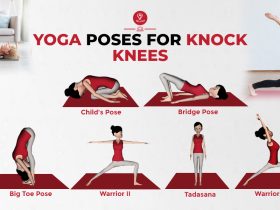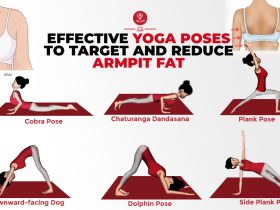
Downward-facing dog, triangle, locust pose, plank, upward-facing bow, cat-cow stretch, and chair pose are four of the best poses of yoga for strong back and core as well as better spinal alignment.
It is true that to strengthen your back, focusing on the core muscles can provide some additional benefits. A weak core and poor posture from constantly sitting in chairs are actually common contributing factors to lower back pain and discomfort, especially with aging. And yoga for the spine is one such exercise method that can target the all-important back areas.
Simply put, the movements used in yoga are great for working on flexibility and core stability, building strength and mobility, and correcting posture – all of which are essential for a healthy & strong back.
If you have a problem that requires medical attention, connecting with a doctor or physical therapist may be the best way to do so.
Choose five or six yoga poses to put into practice for a strong back, and plan on holding each pose for 10 seconds to one minute. Remember that a healthy spine requires a balance between strength and flexibility, so breathe deeply throughout the hold.
5 Poses Yoga For Strong Back & Core Strength
Here are five of my favorite yoga poses and stretches that are also suitable for beginners and for a strong back and developing core strength.
Make sure always listen to your body first and rest if you feel you are surpassing your capacity for the day. And You should pause the practice and start over again if you need to.
Downward-facing dog
Adho Mukha Svanasana is equal parts strengthening and stretching, which can help to build better balance and flexibility throughout your whole body. while stretching the hamstrings and calves strengthens the core and improves circulation.
- Sit on the floor with your knees bent.
- Bend forward at the hips and place your hands on the floor and palms on the floor by joining the shoulders.
- Place palms shoulder-width apart and feet hip-width apart.
- Now slowly lift your knees off the floor and allow your hips to move towards the ceiling, the toes should be towards the hands so that your feet rest on the floor.
- Now straighten your arms and legs to form an inverted V shape.
- Wrists should be in line with elbows and shoulders, and feet should be in line with respective knees and hips.
- Keep the head between the elbows.
- Hold the pose for a few minutes, and then slowly come out of the pose.
Triangle Pose
To get full back strengthening and stretching benefits practice Trikonasana and make sure your core is fully engaged. This protects the back while strengthening core muscles because it stretches out the side backs of the legs and lengthens the spine.
- Stand with a distance of at least one foot between both feet.
- Lift the right hand up towards the sky, bend down while stretching it up, and touch the heel of the left foot with the left hand.
- Keep in mind, to take a deep breath while raising the hand and exhale while touching the heel of the foot. Stay in that position for 10 seconds.
- Do the reverse of the above pose also. That is, raise the left hand up and touch the heel of the right foot with the right hand.
Locust Pose Yoga
Locust pose (Salabhasana) starts with you laying on your belly to take some back and abdominal strength, plus mental fortitude to hold the pose. Here you will be engaging nearly every muscle in your back that builds up core strength and stretching your chest.
- Lie down on your stomach.
- Now make half-fists with the palms of both your hands and place them under your thighs.
- Now try to keep your chin fixed on the ground while stretching it in front.
- Now let your body loose keeping in mind the right way.
- Now keep both your legs straight together.
- Now while inhaling try to raise both legs upwards.
- Wait as long as you are stopped in this state.
- After that try to come down slowly while exhaling.
Plank Pose Yoga
The plank pose in yoga used as a transitional pose requires the most amount of core strength. Hold this asana for 30 seconds a few times a day for strengthening your abdominals, back, core, glutes, and legs. This arm balance is most used to develop core strength and stability.
- Lie down on your stomach.
- Now bring your hands to the sides of your chest and keep your body weight on your forearms.
- Slowly, begin to raise your entire body on the strength of your forearm.
- Keep in mind that your back should be straight and your toes should be perpendicular to the floor.
- Hold for a few breaths.
Chair Pose Yoga
Chair pose in yoga demands strength and stamina in the body, but yields deep and lasting results. when you try it, you’ll find improves balance and strengthens your core, thighs, and ankles.
- Stand on the mat and spread your feet at hip width. Keep all the toes of the feet together.
- Extend your arms up, palms facing each other.
- Bend both your knees and come to a sitting position on a chair.
- During this, most of your body weight should be on your ankles.
- Stretch your shoulder blades toward each other and down.
- Try to keep your shoulders away from your ears.
- Stay in this position for 60 seconds.
- Release and repeat it again.
Conclusion
Yoga can be a great way to get strength back and core muscles. Practice the above asanas every day or every other day to strengthen and tone the muscles of the core. Developing core strength is essential for maintaining a healthy spine and limber for life!
RELATED ARTICLES
May 20, 2025
Kegel Exercises: Strengthen Your Pelvic Floor for Better Health
Kegel exercises strengthen the pelvic floor muscles, which support the uterus, bladder, small intestine and rectum. Strengthening these muscles improves[...]
Oct 06, 2024
Balance Your Body: Yoga Poses For Knock Knees (Genu Valgum)
Knock knees, or “genu valgum,” is a condition in which the knees touch each other while the ankles remain apart.[...]
Sep 20, 2024
Effective Yoga Poses to Target and Reduce Armpit Fat
Fat accumulation under the arms is a common problem for many women, which is often considered an important part of[...]
RECENT POSTS
Disclaimer
The content is purely informative and educational in nature and should not be construed as medical advice. Please use the content only in consultation with an appropriate certified medical or healthcare professional






